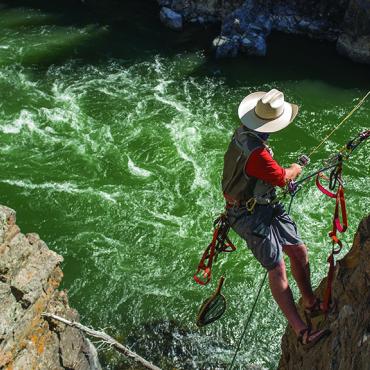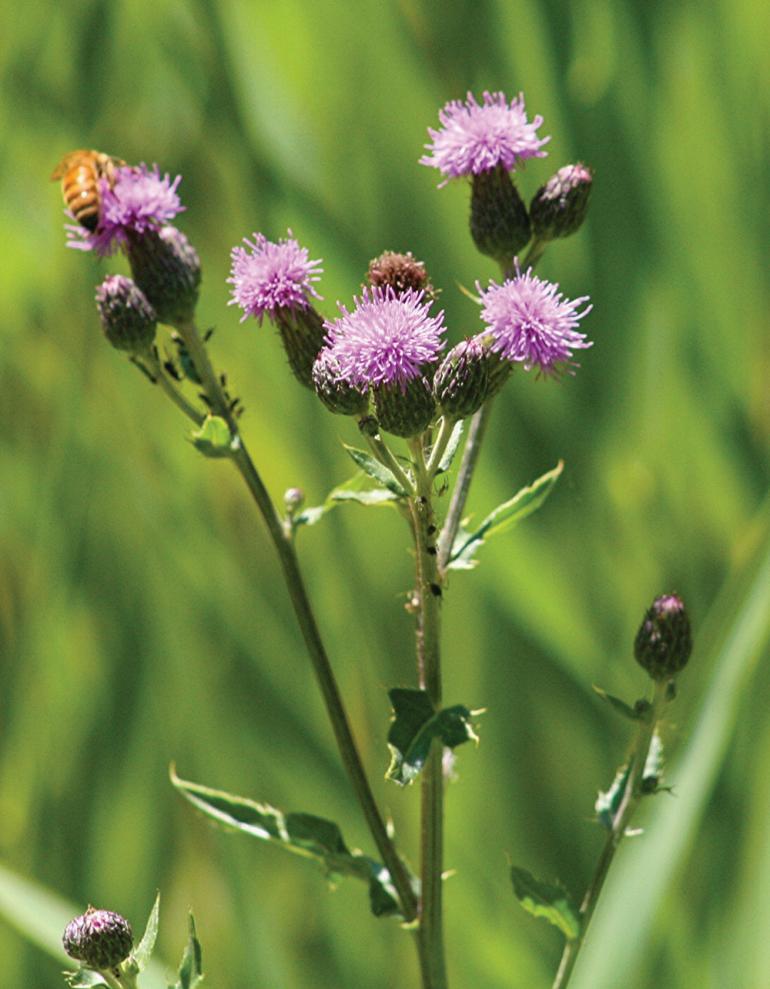Injurious Interlopers
Spotting Montana’s most invasive species.
Most outdoorsy folks in Bozeman know the common invasive-plant species ’round these parts—the telltale spikes of Canada thistle, the milky-white sap of leafy spurge, the purple flowers of spotted knapweed. Then there are a few plants that take a little more know-how to properly identify, but are equally as noxious—common tansy and oxeye daisy, to name a couple. Yet still there are other invasives—species that blend into their surroundings, mimicking the looks and behaviors of similar species, only to spread their seeds with reckless abandon. They often overtake the environment and edge out the existing life, leading to an adverse transformation of the landscape. Here are several invasives to look out for this summer.
California Thistle (Technologia remotus)
Appearance: Encased in the hard shell of a Tesla or nose-deep in a MacBook. If neither are readily apparent, look for Arc’teryx or Patagonia clothing labels.
Distribution: Predominantly southwest Montana, but ranging northwest to Whitefish and Missoula.
Reproduction: Seen only in the summer months; does not reproduce in harsh climates. Was seasonal visitor prior to the proliferation of remote work; now year-round pests.
Abundance: Steadily increasing in numbers, so no exact figure can be given. Population is sure to grow for the foreseeable future.
Longevity: 1-3 years; varies by number of days below 32 degrees and availability of remote tech jobs.
Mitigation: Impossible to cull, but reduce its population by commenting loudly on their license plates, informing them of how restrictive Montana’s recycling regulations are, and insisting there is nowhere in town to get a decent cup of coffee.
Beefy Scourge (Allhat nocattle)
Appearance: Stetson hat, Wrangler jeans, brand-new boots, and lifted truck without a speck of dirt.
Distribution: Primarily in towns and cities throughout western Montana, far from ranches or any place requiring a hard day’s work. Congregate in thick clusters at locales such as Stacey’s and the R-Bar.
Reproduction: Attempts to copulate after a night of swing dancing at the Jump or during summer rodeos. Frequently unsuccessful.
Abundance: Prolific in southwest Montana, with population increases directly correlated to new seasons of the TV show Yellowstone. With the series soon coming to an end, the population will likely take a hit.
Longevity: 2-10 years (long enough to realize working on a ranch is hard and owning one is even harder).
Mitigation: Offer this species manual-labor jobs, call ’em “cowboy” in a sarcastic tone, and publicly compare them to the protagonists of Brokeback Mountain.
Spotted Dirtbag (Sordof adventurus)
Appearance: Homeless, but vehicle laden and adorned with excessive outdoor gear; perpetually void of steady income.
Distribution: Widespread in southwest Montana, but located near any ski town, climbing crag, runnable river, or event with free beer.
Reproduction: Rare, due to poor hygiene and finances. Reproduces only on occasion, usually upon metamorphosis from Spotted Dirtbag to Spotted Disappointment.
Abundance: Always limited, but increasing with advances in car-camping technology.
Longevity: Varies based on weather-dependent factors such as snowfall and runoff.
Mitigation: Relatively harmless; mitigation should be done lightly. Offer them a desk job or suggest that guiding whitewater in Idaho is far better than in Montana.
Common Pansy (Collegium infantus)
Appearance: Floral pattern, thick glasses, Chelsea boots, and “I’m better than you” facial expression.
Distribution: Stays close to its own kind; only in locales with college campuses.
Reproduction: Shies away from face-to-face interaction; requires inebriation to mate. Mating dances vary, but always performed on Friday or Saturday evenings downtown.
Abundance: Inundates most college towns; seasonally large fluctuations. Lowest density at winter break, highest at early-September music festivals.
Longevity: 2-4 years, or whenever daddy’s money runs out.
Mitigation: Attempts are mostly fruitless; however, one promising solution is to petition the local university to require gainful employment as a stipulation of enrollment.
Oxford Praise-Me (Writerus magazinae)
Appearance: Hybrid look of business professional and stay-at-home mom; neatly dressed with frazzled hair, bags under eyes, and coffee-stained teeth.
Distribution: Populated areas, coffee shops, office spaces; perpetually chained to laptop.
Reproduction: Akin to that of wolverines and Tasmanian devils. These curmudgeonly, self-righteous beings have difficulty engaging with others and often come off as abrasive when courting.
Abundance: Rarest of all invasives. Only a few remain after years of nonstop culling efforts. Some other species, such as the Common Pansy, attempt to replicate with mimicry. May go extinct naturally, as computer-generated-writing technology improves.
Longevity: Varies based on readership; generally 1-2 years, soon wilting after exhaustion of savings.
Mitigation: As the name suggests, the Oxford Praise-Me relies on adulation to feed its existence and ego. Simply withhold compliments of any kind for this breed to accelerate its demise.
















